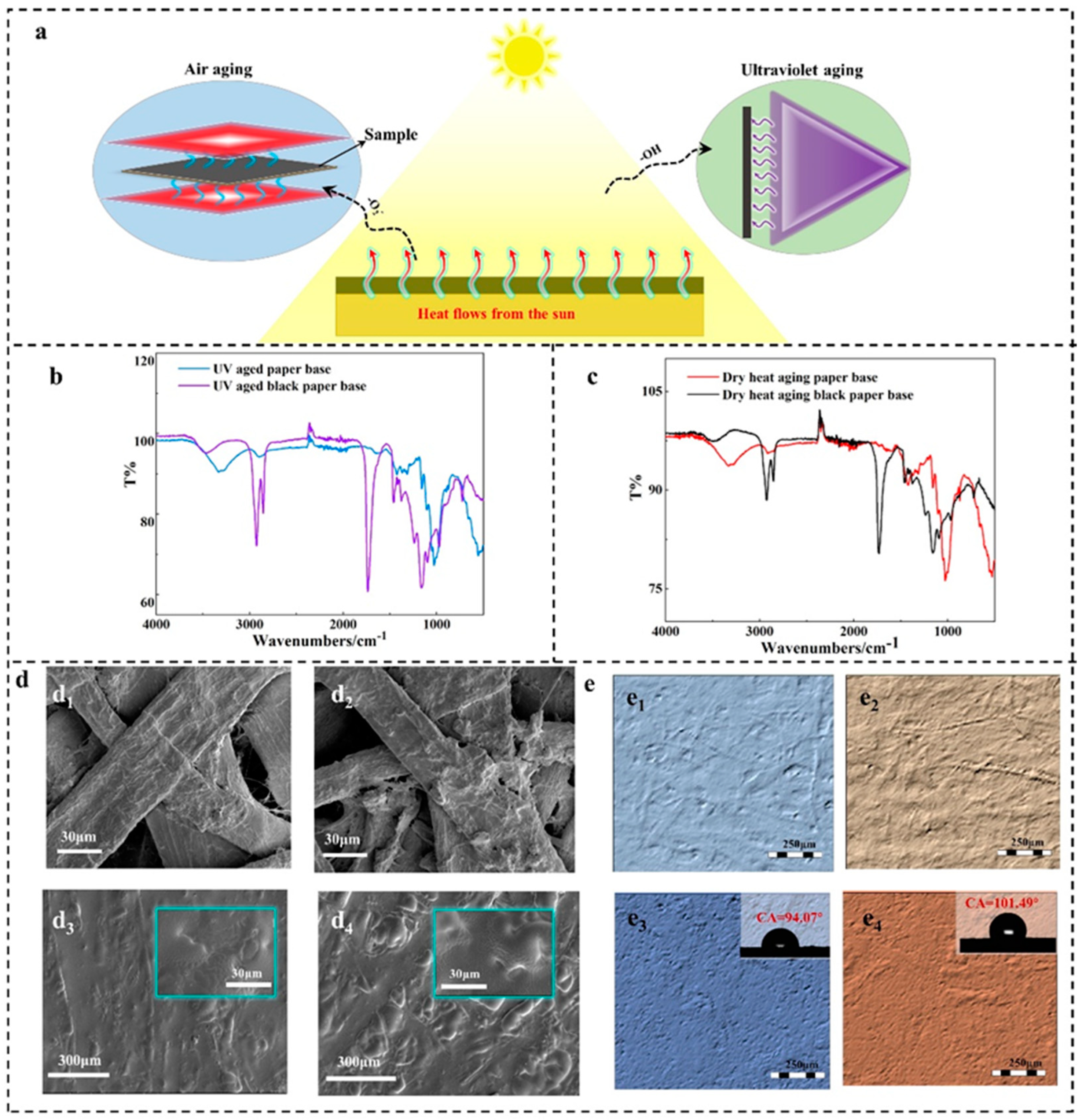Feasibility Study on Biodegradable Black Paper-Based Film Solidified Using Cooked Tung Oil
Abstract
1. Introduction
2. Materials and Methods
2.1. Experimental Materials and Equipment
2.2. Preparation of Black Paper-Based Film
3. Results and Discussions
3.1. Surface Morphology Analysis
3.2. Mechanical Properties
3.3. Hydrophobic Property
3.4. Efficient Heat Transfer Performance
3.5. Weather Resistance (UV Aging Resistance, Dry Heat Aging Resistance)
3.5.1. Mechanical Analysis of Weather Resistance
3.5.2. Analysis of Weatherability and Hydrophobicity
3.5.3. Analysis of Weather Resistance Mechanism
4. Conclusions
Author Contributions
Funding
Institutional Review Board Statement
Informed Consent Statement
Data Availability Statement
Conflicts of Interest
References
- Wang, X.; Fan, J.; Xing, Y.; Xu, G.; Wang, H.; Deng, J.; Wang, Y.; Zhang, F.; Li, P.; Li, Z. The Effects of Mulch and Nitrogen Fertilizer on the Soil Environment of Crop Plants. Adv. Agron. 2019, 153, 121–173. [Google Scholar] [CrossRef]
- Arora, V.K.; Singh, C.B.; Sidhu, A.S.; Thind, S.S. Irrigation, tillage and mulching effects on soybean yield and water productivity in relation to soil texture. Agric. Water Manag. 2011, 98, 563–568. [Google Scholar] [CrossRef]
- He, Q.; Wang, J.; Wang, G.; Hao, X.; Li, A. Construction of a durable superhydrophobic flame-retardant coating on the PET fabrics. Mater. Des. 2023, 233, 112258. [Google Scholar] [CrossRef]
- Wang, Y.; Xie, Z.; Malhi, S.S.; Vera, C.L.; Zhang, Y.; Guo, Z. Effects of gravel–sand mulch, plastic mulch and ridge and furrow rainfall harvesting system combinations on water use efficiency, soil temperature and watermelon yield in a semi-arid Loess Plateau of northwestern China. Agric. Water Manag. 2011, 101, 88–92. [Google Scholar] [CrossRef]
- Zhou, L.; Zhang, F.; Liu, C. Improved yield by harvesting water with ridges and subgrooves using buried and surface plastic mulchs in a semiarid area of China. Soil Tillage Res. 2015, 150, 21–29. [Google Scholar] [CrossRef]
- Qi, Y.; Beriot, N.; Gort, G.; Lwanga, E.H.; Gooren, H.; Yang, X.; Geissen, V. Impact of plastic mulch film debris on soil physicochemical and hydrological properties. Environ. Pollut. 2020, 266 Pt 3, 115097. [Google Scholar] [CrossRef]
- Gao, H.; Yan, C.; Liu, Q.; Ding, W.; Chen, B.; Li, Z. Effects of plastic mulching and plastic residue on agricultural production: A meta-analysis. Sci. Total Environ. 2018, 651, 484–492. [Google Scholar] [CrossRef]
- Barnes, D.; Galgani, F.; Thompson, R.C.; Barlaz, M. Accumulation and fragmentation of plastic debris in global environments. Philos. Trans. R. Soc. Lond B Biol. 2009, 364, 1985–1998. [Google Scholar] [CrossRef]
- Brodhagen, M.; Goldberger, J.R.; Hayes, D.G.; Inglis, D.A.; Marsh, T.L.; Miles, C. Policy considerations for limiting unintended residual plastic in agricultural soils. Environ. Sci. Policy 2017, 69, 81–84. [Google Scholar] [CrossRef]
- Miles, C.; DeVetter, L.; Ghimire, S.; Hayes, D.G. Suitability of Biodegradable Plastic Mulches for Organic and Sustainable Agricultural Production Systems. HortScience 2017, 52, 10–15. [Google Scholar] [CrossRef]
- Harada, J.; de Souza, A.G.; de Macedo, J.R.; Rosa, D.S. Soil culture: Influence of different natural fillers incorporated in biodegradable mulching film. J. Mol. Liq. 2019, 273, 33–36. [Google Scholar] [CrossRef]
- Brown, J.E.; Channell-Butcher, C. Black Plastic Mulch and Drip Irrigation Affect Growth and Performance of Bell Pepper. J. Veg. Crop Prod. 2001, 7, 109–112. [Google Scholar] [CrossRef]
- Kasperbauer, M. Strawberry Yield over Red versus Black Plastic Mulch. Crop Sci. 2000, 40, 171–174. [Google Scholar] [CrossRef]
- Anzalone, A.; Cirujeda, A.; Aibar, J.; Pardo, G.; Zaragoza, C. Effect of Biodegradable Mulch Materials on Weed Control in Processing Tomatoes. Weed Technol. 2010, 24, 369–377. [Google Scholar] [CrossRef]
- Massenssini, A.M.; Bonduki, V.H.A.; Melo, C.A.D.; Tótola, M.R.; Ferreira, F.A.; Costa, M.D. Soil microorganisms and their role in the interactions between weeds and crops. Planta Daninha 2014, 32, 873–884. [Google Scholar] [CrossRef]
- Portet, C.; Yushin, G.; Gogotsi, Y. Electrochemical performance of carbon onions, nanodiamonds, carbon black and multiwalled nanotubes in electrical double layer capacitors. Carbon 2007, 45, 2511–2518. [Google Scholar] [CrossRef]
- Wang, Y.; Chen, J.; Cao, J.; Liu, Y.; Zhou, Y.; Ouyang, J.H.; Jia, D. Graphene/carbon black hybrid film for flexible and high rate performance supercapacitor. J. Power Sources 2014, 271, 269–277. [Google Scholar] [CrossRef]
- Nadakatti, S.; Tendulkar, M.; Kadam, M. Use of mesoporous conductive carbon black to enhance performance of activated carbon electrodes in capacitive deionization technology. Desalination 2011, 268, 182–188. [Google Scholar] [CrossRef]
- Kossyrev, P. Carbon black supercapacitors employing thin electrodes-ScienceDirect. J. Power Sources 2012, 201, 347–352. [Google Scholar] [CrossRef]
- Song, J.P.; Tian, K.Y.; Ma, L.X.; Li, W.; Yao, S.C. The effect of carbon black morphology to the thermal conductivity of natural rubber composites. Int. J. Heat Mass Transf. 2019, 137, 184–191. [Google Scholar] [CrossRef]
- Mishra, A.K.; Lahiri, B.B.; Philip, J. Superior thermal conductivity and photo-thermal conversion efficiency of carbon black loaded organic phase change material. J. Mol. Liq. 2019, 285, 640–657. [Google Scholar] [CrossRef]
- Leong, C.K.; Chung, D. Carbon black dispersions as thermal pastes that surpass solder in providing high thermal contact conductance. Carbon 2003, 41, 2459–2469. [Google Scholar] [CrossRef]
- Huang, J.; Yuan, T.; Ye, X.; Man, L.; Zhou, C.; Hu, Y.; Zhang, C.; Yang, Z. Study on the UV curing behavior of tung oil: Mechanism, curing activity and film-forming property. Ind. Crops Prod. 2018, 112, 61–69. [Google Scholar] [CrossRef]
- Zhang, C.; Garrison, T.F.; Madbouly, S.A.; Kessler, M.R. Recent advances in vegetable oil-based polymers and their composites. Prog. Polym. Sci. 2017, 71, 91–143. [Google Scholar] [CrossRef]
- He, Z.; Chapital, D.C.; Cheng, H.N.; Klasson, K.T.; Olanya, O.M.; Uknalis, J. Application of tung oil to improve adhesion strength and water resistance of cottonseed meal and protein adhesives on maple veneer. Ind. Crops Prod. 2014, 61, 398–402. [Google Scholar] [CrossRef]
- Xin, Y.L.; Timar, M.C.; Varodi, A.M.; Yi, S.L. Tung oil and linseed oil as traditional finishing materials important for furniture conservation. Pro Ligno 2015, 11, 571–579. [Google Scholar]
- Huang, Y.; Pang, L.; Wang, H.; Zhong, R.; Zeng, Z.; Yang, J. Synthesis and properties of UV-curable tung oil based resins via modification of Diels–Alder reaction, nonisocyanate polyurethane and acrylates. Prog. Org. Coat. 2013, 76, 654–661. [Google Scholar] [CrossRef]
- Huang, Y.; Ye, G.; Yang, J. Synthesis and properties of UV-curable acrylate functionalized tung oil based resins via Diels–Alder reaction. Prog. Org. Coat. 2015, 78, 28–34. [Google Scholar] [CrossRef]
- GB/T22898-2008; Paper and Board—Determination of Tensile Properties—Constant Rate of Elongation Method (100 mm/min). Standardization Administration of the People’s Republic of China: Beijing, China, 2008.
- GB/T1040.3-2006; Plastics—Determination of Tensile Properties—Part 3: Test Conditions for Films and Sheets. Standardization Administration of the People’s Republic of China: Beijing, China, 2006.
- Wang, S.; Yao, W.; Lu, Z.; Wang, S.; Li, B.; Liu, B. Characterization and durability assessment of fibre-reinforced tung oil lime putties for restoration. J. Build. Eng. 2021, 38, 102241. [Google Scholar] [CrossRef]
- Samadzadeh, M.; Boura, S.H.; Peikari, M.; Ashrafi, A.; Kasiriha, M. Tung oil: An autonomous repairing agent for self-healing epoxy coatings. Prog. Org. Coat. 2011, 70, 383–387. [Google Scholar] [CrossRef]
- Jagtap, A.R.; More, A. Developments in reactive diluents: A review. Polym Bull. 2022, 79, 5667–5708. [Google Scholar] [CrossRef]
- GB/T 464-2008; Paper and Board—Accelerated Aging—Dry Heat Treatment. Standardization Administration of the People’s Republic of China: Beijing, China, 2008.
- Wang, J.; Zhang, Y.; He, Q. Stretchable superhydrophobic fluororubberfabricated by transferring mesh microstructures. Soft Matter 2023, 19, 1560. [Google Scholar] [CrossRef] [PubMed]
- He, Q.; Ma, Y.; Wang, X.; Jia, Y.; Li, K.; Li, A. Superhydrophobic flexible silicone rubber with stable performance, anti-icing and multi-level rough structure. ACS Appl. Polym. Mater. 2023, 6, 3c00273. [Google Scholar] [CrossRef]
- Li, A.; Wei, Z.; Zhang, F.; He, Q. A high reliability super hydrophobic silicone rubber. Colloids Surf. A Physicochem. Eng. Asp. 2023, 671, 131639. [Google Scholar] [CrossRef]
- He, Q.; Jia, Y.; Wang, H.; He, J.; Wang, J.; Xu, Y.; Liu, Y.; Li, A. Triple conversion strategy to build anti-de-icing sheets for the leading edge of the rotor blade. Mater. Des. 2024, 237, 112516. [Google Scholar] [CrossRef]
- He, Q.; Li, K.; Xu, Z.; Wang, J.; Wang, X.; Li, A. Research progress on construction strategy and technical evaluation of aircraft icing accretion protection system. Chin. J. Aeronaut. 2023, 36, 1–23. [Google Scholar] [CrossRef]
- Xu, Z.; Zhang, Y.; Li, A.; Wang, J.; Wang, G.; He, Q. Research progress on compounding agent and mechanical test method of fluororubber. J. Appl. Polym. Sci. 2021, 138, 50913. [Google Scholar] [CrossRef]
- He, Q.; Xu, Y.; Zhang, F.; Jia, Y.; Du, Z.; Li, G.; Shi, B.; Li, P.; Ning, M.; Li, A. Preparation methods and research progress of super-hydrophobic anti-icing surface. Adv. Colloid Interface Sci. 2023, 323, 103069. [Google Scholar] [CrossRef]








Disclaimer/Publisher’s Note: The statements, opinions and data contained in all publications are solely those of the individual author(s) and contributor(s) and not of MDPI and/or the editor(s). MDPI and/or the editor(s) disclaim responsibility for any injury to people or property resulting from any ideas, methods, instructions or products referred to in the content. |
© 2024 by the authors. Licensee MDPI, Basel, Switzerland. This article is an open access article distributed under the terms and conditions of the Creative Commons Attribution (CC BY) license (https://creativecommons.org/licenses/by/4.0/).
Share and Cite
Wu, Y.; Shi, Y.; Zhao, Y.; Yin, Y. Feasibility Study on Biodegradable Black Paper-Based Film Solidified Using Cooked Tung Oil. Coatings 2024, 14, 284. https://doi.org/10.3390/coatings14030284
Wu Y, Shi Y, Zhao Y, Yin Y. Feasibility Study on Biodegradable Black Paper-Based Film Solidified Using Cooked Tung Oil. Coatings. 2024; 14(3):284. https://doi.org/10.3390/coatings14030284
Chicago/Turabian StyleWu, Yi, Yicheng Shi, Yudie Zhao, and Yu Yin. 2024. "Feasibility Study on Biodegradable Black Paper-Based Film Solidified Using Cooked Tung Oil" Coatings 14, no. 3: 284. https://doi.org/10.3390/coatings14030284
APA StyleWu, Y., Shi, Y., Zhao, Y., & Yin, Y. (2024). Feasibility Study on Biodegradable Black Paper-Based Film Solidified Using Cooked Tung Oil. Coatings, 14(3), 284. https://doi.org/10.3390/coatings14030284






